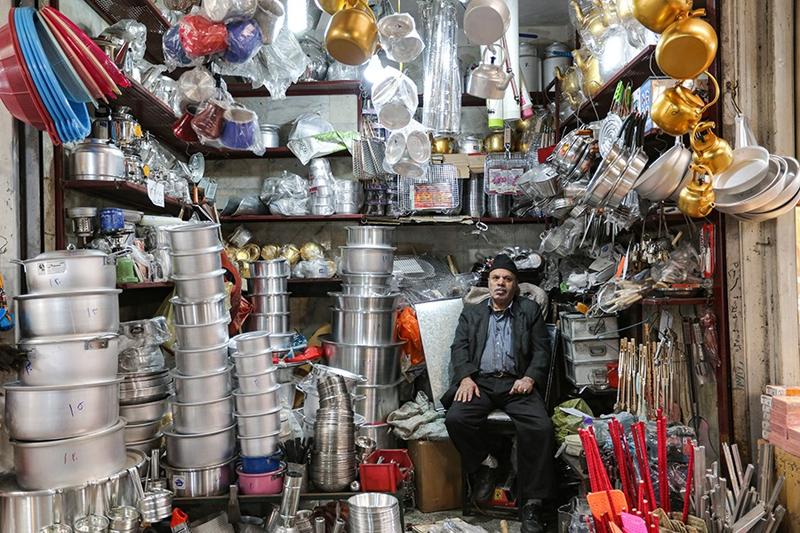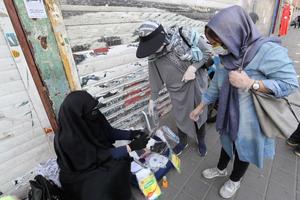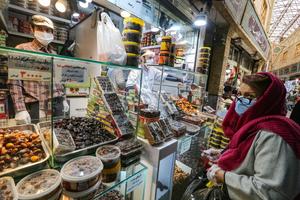Series of aid consignments received from China
 A kitchenware trader awaits customers at his shop in Tajrish Bazaar, Teheran, during Ramadan. (ATTA KENARE / AFP)
A kitchenware trader awaits customers at his shop in Tajrish Bazaar, Teheran, during Ramadan. (ATTA KENARE / AFP)
Editor's Note: Nations are collaborating in the fight against the novel coronavirus outbreak to limit the damage to people's health and the impact on the global economy. Here, in the seventh part of a series titled "One World, One Fight", we look at how countries can work together.
After a brief nationwide lockdown to curb the spread of COVID-19, most Iranians, including those in the capital Teheran, are now allowed to leave their homes for shopping and work.
Low-risk businesses, including many shops and factories, have resumed operations. Shopping malls and bazaars have reopened, along with parks, gardens and recreational areas, which people can visit as long as social distancing is observed.
Many government offices are also back in business, but occupied by only two-thirds of the staff members to reduce crowding, while a ban on intercity travel has been lifted.
The process of receiving generous assistance from people in China is continuing
Seyed Abbas Mousavi, Iranian Foreign Ministry spokesman
In Qom, a city of 1.2 million people situated 140 kilometers south of Teheran, which was the epicenter of the novel coronavirus pneumonia outbreak in Iran, some 24,000 businesses have welcomed the return of customers.
One bookseller in the city said, "We have disinfected the shop and are providing gloves for customers."
On April 18, when low-risk businesses in Teheran began to reopen, the number of new deaths from COVID-19 in Iran fell to a record low.
The first two confirmed cases of the novel coronavirus were reported in Iran on Feb 19. Later that day, the Ministry of Health and Medical Education said both patients had died in Qom.
In the following days, more people tested positive for COVID-19-many of them either from Qom or with links to the city, the country's seventh-largest.
High-ranking officials were not spared.
On March 2, a council member advising Iran's supreme leader died from the disease at a Teheran hospital-the first top official to succumb to the virus, which has infected some members of the Islamic republic's leadership.
Fatemeh Rahbar, who had just been elected to parliament in Teheran, died from the virus on March 7.
The outbreak hit the country just weeks before Nowruz, the Iranian New Year holiday in late March-traditionally a time for mass gatherings and festivities.
During the two-week celebration period, the number of newly confirmed cases in Iran peaked. A total of 1,028 such cases was reported on March 22, while eight days later, a record 3,186 new cases were confirmed.
 Iranian women wearing protective face masks and gloves shop from a street vendor in Tehran, capital of Iran, on May 9, 2020. (ATTA KENARE / AFP)
Iranian women wearing protective face masks and gloves shop from a street vendor in Tehran, capital of Iran, on May 9, 2020. (ATTA KENARE / AFP)
Door-to-door screening
Since the start of the outbreak, Iran has made every effort to curb the spread of the virus.
Since March 3, health authorities have formed some 300,000 teams to conduct door-to-door screening. These tests have helped locate those infected with the virus and have cut off transmission routes.
Key companies and factories were authorized by the government to speed up production of detergents, disinfectants and other hygiene products to meet huge demand.
The army has joined health officials and medical workers in battling the virus.
On March 3, Iran's Supreme Leader Ayatollah Ali Khamenei told government agencies, his own office and the armed forces to cooperate fully with the health ministry.
A "biodefense headquarters" was set up by the armed forces to provide extensive services to patients. About 300,000 soldiers and members of Basij, the volunteer force of Iran's Revolutionary Guard, were ordered to sanitize public areas, direct traffic and trace infected patients' contacts.
The army drew up an alternative plan for military parades, aimed at preventing large gatherings of people to contain the virus and help medical workers.
During celebrations to mark Army Day and Ground Force Day on April 17, Iranian military units held health service parades nationwide to show their readiness to assist in the battle against the virus.
The parades were held in Teheran and 24 provincial capitals. Instead of showcasing armaments and military gear, army units displayed disinfection equipment, mobile hospitals, special vehicles for disinfecting and sanitizing public areas, as well as humanitarian aids.
In addition to mobilizing more manpower, Iran has built many hospitals to handle the increasing number of patients.
On March 1, a municipal official in the central province of Yazd said a special hospital would be set up in Yazd city to treat confirmed patients and to contain the virus.
The hospital covers 1,000 square meters and has an emergency ward and a warehouse to store equipment to tackle biohazards.
In early March, Iran's Ministry of Roads and Urban Development prepared 14 new hospitals in different cities to meet the increasing need for treatment.
Makeshift medical centers with thousands of beds opened in venues such as the Teheran International Permanent Fairground. The centers are being used as hospitals or convalescent homes for patients with COVID-19.
 A shopper wearing a face mask and plastic gloves stands at a date stall in Tajrish Bazaar in Iran's capital Tehran on April 25, 2020, during the Muslim holy month of Ramadan. (ATTA KENARE / AFP)
A shopper wearing a face mask and plastic gloves stands at a date stall in Tajrish Bazaar in Iran's capital Tehran on April 25, 2020, during the Muslim holy month of Ramadan. (ATTA KENARE / AFP)
Before the Nowruz holiday, the Ministry of Health and Medical Education urged Iranians to avoid unnecessary travel during the break, especially as the pandemic showed no signs of easing.
On March 22, major shopping malls and centers nationwide closed for two weeks to prevent the virus spreading, but pharmacies, supermarkets, groceries and bakeries remained open. Four days later, an intercity travel ban was imposed.
Hossein Zolfaghari, a member of the national headquarters fighting the virus, urged people who traveled during the holiday to return to their home cities immediately, adding that those who ignored the order would face legal consequences.
Meanwhile, tens of thousands of inmates have been temporarily released in Iran to prevent the virus spreading in prisons.
Judiciary chief Ebrahim Raisi said the releases would continue "to the point where this does not create insecurity in society".
A number of industries are playing a key role in the battle against COVID-19.
More than 14,000 workshops have been set up to manufacture face masks, including N95 respirators, for health workers and the public.
Iranian scientists have developed a device that can remotely detect those infected with the virus. By creating a magnetic field, it can locate such cases within a 100-meter radius.
The results of hospital tests show that the device has an 80 percent accuracy rate.
On March 16, the Iranian government agreed to spend an additional US$250 million on importing drugs and medical equipment as part of nationwide efforts to tackle the virus.
The Bank of Iran said funds would be made available as soon as it received a request from the health ministry and related authorities.
Two weeks later, Iranian President Hassan Rouhani said the country would allocate 20 percent of the annual state budget to fight the outbreak.
The equivalent of US$23.75 billion, the allocation includes grants and low-interest loans for those affected by the pandemic. However, it is far from sufficient to enable to Iran to get through such a challenging time, especially amid economic sanctions from the United States.
Iranian Foreign Minister Mohammad Javad Zarif said the sanctions, reimposed after the US unilaterally withdrew from the 2015 nuclear deal in May 2018, have drained his country's economic resources and impaired its ability to fight the pandemic.
The sanctions restrict global trade with Iran, affecting its crude oil sales, banking and other industries.
Iran has called many times for a global campaign for the measures to be ignored. "They (the sanctions) literally kill innocents," Zarif said.
 Iranian workers set up a makeshift hospital inside the Iran Mall, northwest of Tehran, on March 21, 2020 amid the coronavirus outbreak. (PHOTO / AFP)
Iranian workers set up a makeshift hospital inside the Iran Mall, northwest of Tehran, on March 21, 2020 amid the coronavirus outbreak. (PHOTO / AFP)
Help from China
Just a week after the first two COVID-19 cases were diagnosed in Iran, the Peaceland Foundation, a nongovernmental rescue organization, sent the first batch of 1,000 nucleic acid test kits from China to Iran on Feb 25.
In the coming days, the second batch arrived, and on March 7, the foundation delivered the third, consisting of 2,500 rapid detection reagents, to the Iranian embassy in Beijing, followed by a fourth batch on March 16.
Wang Ke, who founded the organization, which sent a team to Iran in April last year to help deal with flooding, said, "We learned about the situation in Iran from the news and thought we could help, so we contacted the embassy to see what was needed."
He immediately got in touch with factories and companies producing personal protective equipment, disinfection materials and test kits.
Many people he reached were "very supportive", and provided the goods and materials free of charge. "They knew that if the virus spread wildly overseas, it would in turn place huge pressure on China," Wang said.
Since March 5, another nonprofit social organization, the China-Arab Exchange Association, has donated eight aid packages to Iran worth a total of more than 2 million yuan (US$282,000).
Chen Xinhui, the association's secretary-general, said, "Iran sent a military aircraft to help us fight the virus when it heard about the outbreak (in China). So, when we saw the same thing happen to Iran, we thought of helping them.
"The biggest difficulty we faced was a shortage of materials. Although the outbreak in China has basically been under control since March, there was still a gap between production and supply."
Chen and his colleagues raised a considerable amount of aid, including various types of personal protective equipment, detection reagents and disinfectant.
Iranian Foreign Ministry spokesman Seyed Abbas Mousavi said the first consignment sent to Iran by the Chinese government and the Red Cross, which included about 20,000 coronavirus test kits and other supplies, reached the country on Feb 28.
On March 14, Mousavi said, "The process of receiving generous assistance from people in China is continuing, and at present, a large amount of aid-about 32,000 kilograms of various supplies-has been packed and is going to be shipped to Iran on the next flights."
The Communist Party of China's International Liaison Department has sent a shipment of medicine, N95 respiratory masks and disposable face masks to Iran.
The department's head, Song Tao, said in a letter to the Secretary of Iran's Expediency Council, Mohsen Rezaei, that China was ready to launch scientific cooperation and share its experience with Iran in the battle against the virus.
On April 16, Zarif, the Iranian foreign minister, published a "thank-you note" in Chinese on his Twitter account.
The note stated, "I thank China for providing Iran with anti-epidemic materials, sending medical experts, and condemning the continued illegal sanctions by the United States that have seriously hindered Iran's efforts to fight the epidemic."
Threat not over
Although Iran remains one of the countries in the Middle East hardest hit by the virus, the number of new daily cases has fallen, triggering hopes that the country may be turning the tide.
On April 22, Iranian Health Minister Saeed Namaki said that in the previous 18 days, "thanks to divine blessing as well as the efforts of our colleagues ... we were able to reduce the number of new patients by 53 percent and the death toll by 30 percent daily".
Iranian government spokesman Ali Rabiee also said the infection rate and the number of deaths from COVID-19 are falling in Iran.
However, Iraj Harirchi, deputy minister of health, said a decline in the number of cases in the hardest-hit provinces, such as Qom and Gilan, does not mean that the threat is over, but that precautionary measures must continue to avert a new peak.
"Until further notice, a second, third and umpteenth peak is quite probable throughout the world, even in countries that are apparently clear (of the virus)," he said.
Harirchi added that people must get used to living with the virus and should observe health advice and social distancing regulations until a vaccine is produced.
He said the health ministry had launched the second stage of nationwide screening programs, with more than 99 percent of the population covered in the first stage.
Rabiee said, "We must live with social distancing and follow instructions until the day the health ministry announces that the virus has been defeated."


